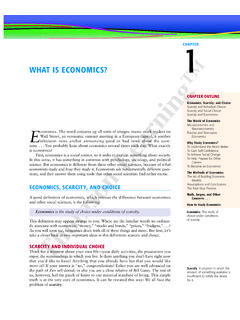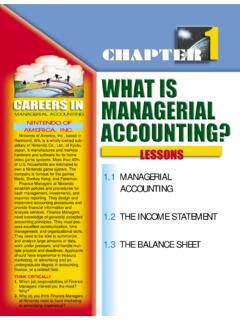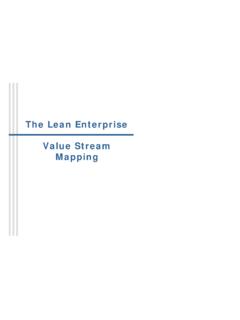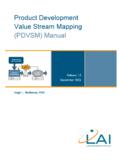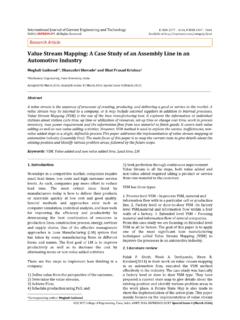Transcription of Part One - Cengage Learning
1 1. part One Chapter 1. Strategic Management and Strategic Competitiveness Chapter 2. The External Environment: Opportunities, Threats, Industry Competition, and Competitor Analysis Chapter 3. The Internal Environment: Resources, Capabilities, and Core Competencies PO/PT. Strategic Management Inputs Strategic Management and Strategic Competitiveness 1. Chapter One Knowledge Objectives Studying this chapter should provide you with the strategic management knowledge needed to: 1. Define strategic competitiveness, competitive advantage, and above-average returns. 2. Describe the 21st-century competitive landscape and explain how globalization and technological changes shape it.
2 3. Use the industrial organization (I/O). model to explain how firms can earn above-average returns. 4. Use the resource-based model to explain how firms can earn above-average returns. 5. Describe strategic intent and strategic mission and discuss their value. 6. Define stakeholders and describe their ability to influence organizations. 7. Describe the work of strategic leaders. CREDIT LINE TO COME. 8. Explain the strategic management process. Research and development is critical to the success of innovative companies such as Samsung, Sony, and Verizon. Continuous development of new products . although costly and sometimes difficult to achieve.
3 Is an important aspect of strategic competitiveness. The Innovation Pipeline: A Lifeline of Survival in Business Conventional wisdom says to get back to the basics. Conventional wisdom says to cut costs. Conventional wisdom is doomed. The winners are the innovators who are making bold thinking an everyday part of doing business. Gary Hamel, 2002. Innovation has become an absolute necessity to survive and perform well in almost every industry. The current competitive landscape demands innova- tion. Gary Hamel, a well-known writer and management consultant, argues that firms cannot rely on past successes to perform well today. Furthermore, he suggests that current success will not carry firms into the future.
4 Man- agers must have the foresight and courage to continuously innovate. Thus, a firm's strategy must include continuous innovation. DuPont, once known as a highly innovative company, lost its way. As one author noted, the company has mostly shot blanks in the last decade. Analysts suggest that too many resources have been diverted from developing innovative products to focus on increasing the productivity of its current businesses. Furthermore, the firm's managers have been criticized for failing to evaluate the market effectively and thereby missing primary opportunities, such as in the agricultural biotechnology field. It had to sell off its pharma- ceutical business because it could no longer compete against the larger and more innovative companies in the industry.
5 Top executives are also consider- ing divesting some of DuPont's other businesses, accounting for a major portion of its sales, because of poor market performance. Its R&D must be shifted from improving existing products to emphasizing the development of new products. DuPont executives are now in the process of changing the mix of R&D dollars spent from about one-third on creating new products and two-thirds on improving existing ones to two-thirds invested in developing innovative new market entries. Interestingly, the large conglomerate Samsung has continued its suc- cess, largely through innovation. The conventional wisdom was that large, highly diversified firms could not be innovative and most are not.
6 But Sam- sung has been very innovative and is among the leaders in many markets in which it competes. For example, it is the market leader in big-screen TVs, microwave ovens, LCD displays, and DRAM chips. It is number two in the flash memory market and number three in cell phones, MP3 players, and DVD players. Unlike many other large conglomerates, it places a high prior- ity on investments in R&D. To remain a leader in the markets listed above requires a steady stream of innovative products. Innovation is important in many industries, as noted above. For example, Clear Channel Communications, the largest owner of radio stations, recently announced that it would market a CD of live recordings from concerts within five minutes of the conclusion of a show.
7 Verizon recently introduced phone booths where people can gain access to the Internet. The firm's intent is to become the market leader in providing broadband services. Sony, the current market leader in video games, is not resting on its current product line. In 2003 it announced a powerful handheld player designed to beat one of its primary competitors, Nintendo. These firms are using innovation to obtain or maintain market leadership. Without it, they would risk even survival. While innovation is important, it is difficult and costly to achieve. For example, large pharmaceutical competitors are now considering cooperating to develop certain types of drugs because of the costs and risks involved.
8 In fact, an industry task force has recommended establishing a research consor- tium of pharmaceutical companies similar to Sematech in the semiconductor industry. Sematech allowed semiconductor companies to regain compet- itiveness in that industry. Such a research consortium could encourage coop- eration in the development of cancer fighting drugs. The costs and risks involved in R&D make some firms take a conservative approach and focus on improving current products. Such research usually has short-term payoffs but is costly in the longer term when there is a deficit of new products to market. Internal dissension exists at Hewlett-Packard (HP) because of the pressure to reduce costs in R&D, which HP scientists argue is hurting the company's level of innovation.
9 The tight market for computer hardware and the high costs of the Compaq acquisition have caused reductions in HP's R&D budgets. Over time, HP will learn if these pressures will harm its competitiveness. SOURCES: C. Edwards, M. Ihlwan, & P. Engardio, 2003, The Samsung way, Business Week, June 16, 56 64; B. J. Feder, 2003, Verizon sets up phone booths to give access to the Internet, New York Times, May 14, ; Sony takes on Nintendo with new player, 2003, New York Times, May 14, ; A. Pollack, 2003, Companies may cooperate on cancer drugs, New York Times, May 14, ; J. Markoff, 2003, Innovation at Hewlett part 1 / Strategic Management Inputs tries to evade the ax, New York Times, May 5, ; M.
10 Mirapaul, 2003, Concert CD's sold on the spot by a radio giant, New York Times, May 5, ; G. Hamel, 2002, Innovation now! Fast Company, December, Samsung and DuPont's performances are in sharp contrast. DuPont, a once highly inno- vative company, lost its competitive edge. Clearly, DuPont changed its strategy to emphasize productivity and improve its current product line rather than introduce inno- vative new products. Such actions probably improved the firm's profits in the short term. But in the long term, it had to sell off divisions that were no longer competitive and is experiencing major problems because of the lack of innovation. In contrast, Samsung is 4 investing in innovation to remain among the leaders in multiple product markets.

